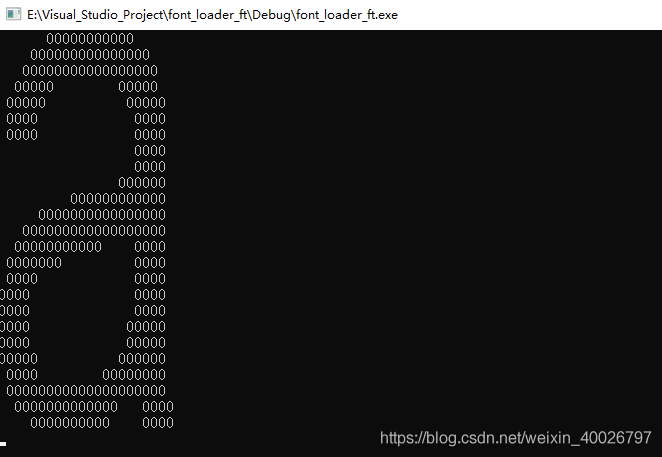# 1 前言
近期工作需要研究 FreeType 库,因此本篇文章记录一下该库的基本用法。
FreeType 是一个免费、开源、可移植且高质量的字体引擎,它有以下优点:
- 支持多种字体格式文件,并提供了统一的访问接口;
- 支持单色位图、反走样位图渲染,这使字体显示质量达到 Mac 的水平;
- 采用面向对象思想设计,用户可以灵活的根据需要裁剪。
但 FreeType 也有缺点,它太大了,即使是裁剪后的阉割版,其代码量也有将近 12 万行,在Flash非常小的开发板可能放不下,此时可以考虑用代码量较小的 stb_truetype 库,具体用法可以参考我之前发的博客:stb_truetype解析ttf字体并将其保存到图片中。
注意:本文采用的 FreeType 库为 AWTK 中的裁剪版,只有一个巨大的头文件 freetype.h (opens new window)。
AWTK是 ZLG 开发的开源 GUI 引擎,官网地址:https://www.zlg.cn/index/pub/awtk.html (opens new window)。
# 2 FreeType解析矢量字体
使用 FreeType 库将矢量字体解析为位图的步骤详见下文。
# 2.1 包含头文件
此处采用裁剪版的 FreeType 库,需要包含的头文件如下:
#include "freetype.h"
如果采用完整版的 FreeType 库,需要包含的头文件如下:
#include <ft2build.h>
#include <freetype/freetype.h>
#include <freetype/ftglyph.h>
#include <freetype/ftpfr.h>
#include <freetype/ftadvanc.h>
# 2.2 初始化FreeType库
使用 FT_Init_FreeType() 函数初始化一个 FT_Library 句柄,例如:
FT_LIBRARY library; //FreeType库的句柄
FT_Error error = FT_Init_FreeType( &library );
if ( error )
{ /* 初始化失败 */ }
# 2.3 加载FT_Face
FT_Face 是矢量字体的外观对象,用于保存字体外观数、当前外观索引、当前外观所包含字形文件数等相关数据,其中外观可简单理解为常规、斜体、加粗等字体风格,加载 FT_Face 有两种方式,一是通过字体文件名加载,二是从内存中加载,具体如下:
- 通过字体文件名加载FT_Face:
FT_Face face; //FT_Face对象的句柄
FT_New_Face( library, "/usr/share/fonts/truetype/arial.ttf", 0, &face);
- 从内存中加载 FT_Face:
FT_Face face; //FT_Face对象的句柄
FT_New_Memory_Face(font_info.library, font_buf, size, 0, &face);
# 2.4 设置字体编码方式
此处设置字体编码方式为Unicode,如果不设置,FreeType默认为 utf-16编码类型:
FT_Select_Charmap(face, FT_ENCODING_UNICODE);
# 2.5 设置字体大小
方法一:通过物理距离设置字体大小
FT_Set_Char_Size( FT_Face face,
FT_F26Dot6 char_width, //字符宽度,单位为1/64点
FT_F26Dot6 char_height, //字符高度,单位为1/64点
FT_UInt horz_resolution, //水平分辨率
FT_UInt vert_resolution ); //垂直分辨率
字符宽度和高度以1/64点为单位表示。
- 点是物理上的距离,一个点代表1/72英寸(2.54cm),
- 分辨率以dpi(dots per inch)为单位表示,表示一个英寸有多少个像素。
例如:
FT_Set_Char_Size( face, 36 * 64, 0, 96 , 0); //0表示与另一个尺寸值相等。
字符的物理大小:36 * 64 * (1/64) * (1/72) 英寸 字符的像素宽高: 36 * 64 * (1/64) * (1/72) * 96
方法二:通过像素宽高设置字体大小
FT_Set_Pixel_Sizes( FT_Face face,
FT_UInt pixel_width, //像素宽度
FT_UInt pixel_height ); //像素高低
例如:
FT_Set_Pixel_Sizes(face, 0 ,16); //把字符像素设置为16*16像素, 0表示与另一个尺寸值相等。
# 2.6 加载字形图像
# 2.6.1 获取字符编码的字形索引
通过 FT_Get_Char_Index() 函数将字符编码转换为一个字形(glyph)索引,例如:
wchar_t char_code = L'A';
FT_UInt glyph_index = FT_Get_Char_Index(face, char_code); /* 若 glyph_index 为0,表示没找到字形索引 */
# 2.6.2 通过索引从face中加载字形
获得字形索引后,接下来可根据索引将字形图像存储到字形槽( FT_GlyphSlot )中。
字形槽:每次只能存储一个字形图像,每个face对象都有一个字形槽,位于face->glyph。
通过 FT_Load_Glyph() 来加载一个字形图像到字形槽:
FT_Load_Glyph(face, glyph_index, load_flags); /* load_flags:装载标志,一般填FT_LOAD_DEFAULT */
并且更新 face->glyph 下的其它成员,比如:
FT_Int bitmap_left; //该字形图像的最左边的X值
FT_Int bitmap_top; //该字形图像的最上边的Y值
# 2.6.3 将字形转化为位图
通过 FT_Render_Glyph() 函数,将字形槽的字形图像转为位图,并存到 face->glyph->bitmap->buffer[]里:
FT_Render_Glyph(face->glyph, render_mode); /* render_mode:渲染模式 */
渲染模式 render_mode 通常设为以下2种:
- FT_RENDER_MODE_NORMAL:表示生成位图是RGB888格式
- FT_RENDER_MODE_MONO:表示生成位图每个像素是1位的(黑白图)
并更新face->glyph->bitmap下的其它成员,比如:
int rows; //该位图总高度,有多少行
int width; //该位图总宽度,有多少列像素点
int pitch: //指一行的数据跨度(字节数),比如对于24位(3字节)的24*30汉字,则pitch=24*3
char pixel_mode //像素模式,1 指单色的,8 表示反走样灰度值
unsigned char* buffer //glyph 的点阵位图内存绶冲区
# 2.6.4 一步到位
也可以直接使用 FT_Load_Char() 来代替 FT_Get_Char_Index()、FT_Get_Load_Glyph() 和 FT_Render_Glyph(),一步到位,例如:
FT_Load_Char(face, char_code, FT_LOAD_RENDER);
其中 FT_LOAD_RENDER 表示直接将图像转为位图,所以不需要使用 FT_Render_Glyph() 函数。
该函数默认生成的位图是 FT_RENDER_MODE_NORMAL 类型,即 RGB888。
若想生成 FT_RENDER_MODE_MONO (二值化位图) 类型,操作如下:
FT_Load_Char(face, char_code, FT_LOAD_RENDER | FT_LOAD_MONOCHROME);
生成出来的二值化位图 face->glyph->bitmap->buffer[] 里的一个字节表示 8 个像素点。
# 2.7 完整示例代码
至此,将矢量字体解析为位图已完成,下面直接上完整的示例代码:
#include <stdio.h>
#include <stdlib.h>
#include <stdint.h>
#include "freetype.h"
/* 字体数据(ttf) */
typedef struct _ft_fontinfo {
FT_Face face; /* FreeType库句柄对象 */
FT_Library library; /* 外观对象(描述了特定字样和风格,比如斜体风格等) */
int32_t mono; /* 是否为二值化模式 */
} ft_fontinfo;
/* 字模格式常量定义 */
typedef enum _glyph_format_t {
GLYPH_FMT_ALPHA, /* 每个像素占用1个字节 */
GLYPH_FMT_MONO, /* 每个像素占用1个比特 */
} glyph_format_t;
/* 字模(位图) */
typedef struct _glyph_t {
int16_t x;
int16_t y;
uint16_t w;
uint16_t h;
uint16_t advance; /* 占位宽度 */
uint8_t format; /* 字模格式 */
uint8_t pitch; /* 跨距(每行像素个数 * 单个像素所占字节数) */
uint8_t *data; /* 字模数据:每个像素点占用一个字节 */
void *handle; /* 保存需要释放的句柄 */
} glyph_t;
/* 获取二值化位图上像素点的值 */
uint8_t bitmap_mono_get_pixel(const uint8_t* buff, uint32_t w, uint32_t h, uint32_t x, uint32_t y) {
/* 计算字节偏移 */
uint32_t line_length = ((w + 15) >> 4) << 1;
uint32_t offset = y * line_length + (x >> 3);
/* 计算位偏移 */
uint32_t offset_bit = 7 - (x % 8);
const uint8_t* data = buff + offset;
if (buff == NULL || (x > w && y > h))
return 0;
return (*data >> offset_bit) & 0x1;
}
/* 获取字模 */
static int font_ft_get_glyph(ft_fontinfo *font_info, wchar_t c, float font_size, glyph_t* g) {
FT_Glyph glyph;
FT_GlyphSlot glyf;
FT_Int32 flags = FT_LOAD_DEFAULT | FT_LOAD_RENDER ;
if (font_info->mono) {
flags |= FT_LOAD_TARGET_MONO;
}
/* 设置字体大小 */
FT_Set_Char_Size(font_info->face, 0, font_size * 64, 0, 96);
//FT_Set_Pixel_Sizes(font_info->face, 0, font_size);
/* 通过编码加载字形并将其转化为位图(保存在face->glyph->bitmap中) */
if (!FT_Load_Char(font_info->face, c, flags)) {
glyf = font_info->face->glyph;
FT_Get_Glyph(glyf, &glyph);
g->format = GLYPH_FMT_ALPHA;
g->h = glyf->bitmap.rows;
g->w = glyf->bitmap.width;
g->pitch = glyf->bitmap.pitch;
g->x = glyf->bitmap_left;
g->y = -glyf->bitmap_top;
g->data = glyf->bitmap.buffer;
g->advance = glyf->metrics.horiAdvance / 64;
if (g->data != NULL) {
if (glyf->bitmap.pixel_mode == FT_PIXEL_MODE_MONO) {
g->format = GLYPH_FMT_MONO;
}
g->handle = glyph;
}
else {
FT_Done_Glyph(glyph);
}
}
return g->data != NULL || c == ' ' ? 1 : 0;
}
int main(int argc, const char *argv[])
{
ft_fontinfo font_info; /* 字库信息 */
long int size = 0; /* 字库文件大小 */
unsigned char *font_buf = NULL; /* 字库文件数据 */
/* 加载字库文件存入font_buf */
FILE *font_file = fopen("../font/default.ttf", "rb");
if (font_file == NULL) {
printf("Can not open font file!\n");
getchar();
return 0;
}
fseek(font_file, 0, SEEK_END); /* 设置文件指针到文件尾,基于文件尾偏移0字节 */
size = ftell(font_file); /* 获取文件大小(文件尾 - 文件头 单位:字节) */
fseek(font_file, 0, SEEK_SET); /* 重新设置文件指针到文件头 */
font_buf = (unsigned char*)calloc(size, sizeof(unsigned char));
fread(font_buf, size, 1, font_file);
fclose(font_file);
font_info.mono = 1; /* 设置为二值化模式 */
/* 初始化FreeType */
FT_Init_FreeType(&(font_info.library));
/* 从font_buf中提取外观 */
FT_New_Memory_Face(font_info.library, font_buf, size, 0, &(font_info.face));
/* 设置字体编码方式为UNICODE */
FT_Select_Charmap(font_info.face, FT_ENCODING_UNICODE);
glyph_t g;
wchar_t c = L'a';
float font_size = 36; /* 设置字体大小 */
font_ft_get_glyph(&font_info, c, font_size, &g); /* 获取字模 */
/* 打印字模信息 */
int i = 0, j = 0;
if (g.format == GLYPH_FMT_MONO) {
for (j = 0; j < g.h; ++j) {
for (i = 0; i < g.w; ++i) {
uint8_t pixel = bitmap_mono_get_pixel(g.data, g.w, g.h, i, j);
if (pixel) {
printf("0");
}
else {
printf(" ");
}
}
printf("\n");
}
}
else if (g.format == GLYPH_FMT_ALPHA) {
for (j = 0; j < g.h; ++j) {
for (i = 0; i < g.w; ++i)
putchar(" .:ioVM@"[g.data[j*g.w + i] >> 5]);
putchar('\n');
}
}
/* 释放资源 */
FT_Done_Glyph(g.handle);
FT_Done_FreeType(font_info.library);
free(font_buf);
getchar();
return 0;
}
输出如下:

# 3 总结
以上便是 FreeType 库的基本用法,可以看出使用过程还是很清晰明了的,其中需要调整的参数主要是字符编码、字体大小(字号)以及渲染模式。
更多资料可以访问以下网址:
- FreeType 库下载: https://www.freetype.org/download.html (opens new window)
- FreeType 英文参考文档下载:https://www.freetype.org/freetype2/docs/documentation.html (opens new window)
- FreeType 中文使用参考:
希望能对大家有所帮助。
